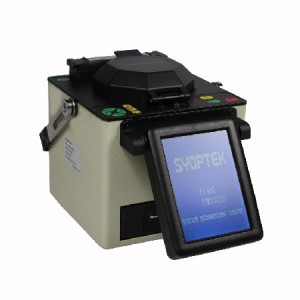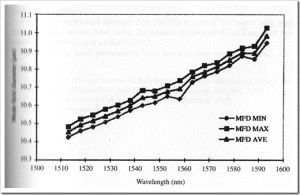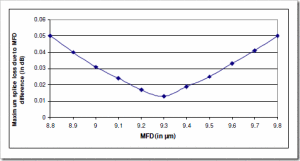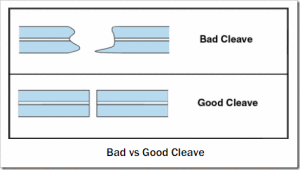 There are two types of factors that fiber splice loss depends on: intrinsic factors and extrinsic factors.
There are two types of factors that fiber splice loss depends on: intrinsic factors and extrinsic factors.
1、intrinsic factors
Mode Field Diameter Mismatch
Intrinsic factors are parameters that you can not control. These factors are determined when the fiber is manufactured and Mode Field Diameter (MFD) is the most critical one.
Differences in the mode field diameter between single mode fibers lead to a signal loss. More splice loss can be observed for higher difference in MFD values.
Here is the formula that calculates splice loss due to mode field diameter mismatch:

Mode field diameter is a characteristic, which describes the mode field (cross-sectional area of light) traveling down a fiber at a given wavelength. You should realize that MFD is a function of wavelength and changes across the C and L bands, as shown below.

The following figure shows maximum splice loss of fiber with particular MFD value with any other fiber of MFD range of 8.8~9.6um. Splice loss of fiber with MFD 9.3um is lowest when spliced with any other fiber of range 8.8~9.6um.

2、Extrinsic Factors
Extrinsic factors include induced by splicing methods and procedures. Splice process factors such as lateral and angular alignment, contamination on fiber end faces, deformation due to un-optimized heating and pressing, etc.
You can control or minimize these extrinsic factors by using a highly skilled technician for the splicing or using high precision automated fusion splice machines.
Miss alignment and other splicing process factors can increase fiber splicing loss. Splice loss as high as 0.04dB is observed with even same MFD and geometry identical fibers. That gives you a good idea on how important these factors are.
Proper fiber end preparation is also very critical to get good splice loss. You should always make sure you are making a good fiber cleave before proceeding with the splice process. The following picture shows good and bad fiber cleaves.

By controlling extrinsic factors, good fiber splice should not be too hard to achieve.